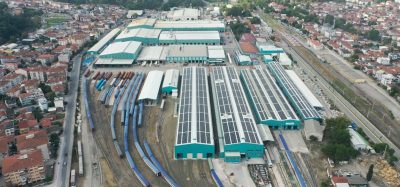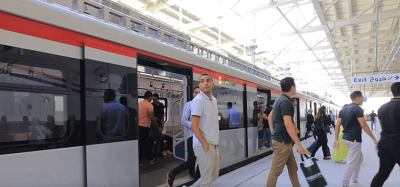Boosting railway infrastructure in Bulgaria
Posted: 3 December 2008 | | No comments yet
The task of the modernisation plan of the Railway Infrastructure of Republic of Bulgaria is to develop the advantages of the country cross-road position and its transit potential with an aim to enhance the country’s integration into the European structures and to support the sustainable development of the Southeast Europe region. It should create preconditions for liberal transport market development and for the continuous increase of quality of transport services.
The task of the modernisation plan of the Railway Infrastructure of Republic of Bulgaria is to develop the advantages of the country cross-road position and its transit potential with an aim to enhance the country’s integration into the European structures and to support the sustainable development of the Southeast Europe region. It should create preconditions for liberal transport market development and for the continuous increase of quality of transport services.
The task of the modernisation plan of the Railway Infrastructure of Republic of Bulgaria is to develop the advantages of the country cross-road position and its transit potential with an aim to enhance the country’s integration into the European structures and to support the sustainable development of the Southeast Europe region. It should create preconditions for liberal transport market development and for the continuous increase of quality of transport services.
In order to achieve the European standards for efficient and safe transport, Bulgarian legislation is harmonised with European legislation. There are created conditions for changing properties within the transport sector and for attracting a significant number of private companies into the transport services market. An important part of the modernisation process is railway infrastructure development. Its modernisation is a mandatory condition to ensure successful integration into the European transport system. The process is supported by significant European funds for which the country prepares priority infrastructure projects and is ready for the co-financing of their construction.
Bulgaria has a high density of constructed railway lines in comparison with many of the other East European countries. The greater part of the lines have geometric parameters, track substructure and structures for speeds of up to 100km/h. The total track length is 6,938km, including a gauge of 1,435mm.
Connections with neighbouring countries’ networks are not very satisfactory. Currently there is one border crossing with Turkey, two with Greece, and one with Serbia, with Romania through the only bridge over the River Danube along the Bulgarian – Romanian section in Russe – Giurgiu and one land crossing. The Varna ferry complex ensures the transportation of railway wagons through the Black Sea. There is no railway connection with the FYRO Macedonia.
Along the railway network there are 148 tunnels with a total length of 44,500m along railway lines with a normal gauge, and 41 tunnels along narrow-gauge railway lines. There are also 1,018 bridges with a total length of 26,400m. The railway switches are approximately 7,800 pcs.
Join our free webinar: Rail cyber-security in a time of technological and regulatory transformation
Join our expert panel, including speakers from Nokia and Siemens Mobility, to explore the critical convergence of cybersecurity and 5G rail comms.
Date: 3 Dec | Time: 15:00 GMT
Can’t attend live? No worries – register to receive the recording post-event.
During recent years and due to a shortage of funds, the track and structure maintenance has suffered. From the mid 90s, the only investments made to the railway infrastructure have been with international programme funds and with a World Bank loan. This led the quality of passenger and freight transportation to decrease and capacity and speed restrictions were enforced along significant railway sections.
Signalling
Signalling Systems and Devices (ST) are aspects of railway infrastructure elements that ensure train movements are managed safely.
The current Signalling and Telecommunication Systems are as follows:
- Routing – computer interlocking (2 pcs)
- Relay interlocking type EC – M – MKW (4 pcs)
- Routing – relay interlocking (206 pcs)
- Electro-mechanical interlocking (50 pcs)
- Manual with switch dependencies (100 pcs)
- Stations with temporary management boards (30 pcs)
- Automatic Block Systems with pass signals – ensuring packet train movement at the open lines (548km)
- Automatic Block Systems without pass signals with axle counters (1,149km)
- Relay Semi-Automatic Block System (2,900km)
Two centers with distance train movement management and control are operated along the railway lines Sofia to Plovdiv and Sofia to Karlovo. 483 railway level-crossings are equipped with automatic crossing devices, which give signals for the coming train passing.
The railway line Sofia to Plovdiv to Bourgas (440km) is maintained by an Automatic Loco Signalling System ETCS Level 1 (ALTRACS – L1), which doesn’t allow the maximum speed of the train to be exceeded or to pass at SPAD signal.
The Telecommunication Cable Network consists of:
- Highway Cables (3,800km)
- Conductors (500km)
- Fiber Optic Lines (282km)
As a result of a completed electrification extension, Bulgaria is a leading country in comparison with East European countries. Currently, 67% of all track in Bulgaria is now electrified. 373 traffic points are in operation and a system has been constructed to measure the energy consumed by the locomotives. We are currently testing the system and it is installed on four locomotives.
Railway lines along the Main European Transport Corridors are included in the European Agreement of International Combined Traffic and connected sites (AGTC). This Agreement also contains the terminals at the territory of Republic of Bulgaria that are of great importance for the International Combined Traffic, as well as for the important border points of Republic of Bulgaria, railway-ferry points and harbours.
It is considered that the general status of railway infrastructure requires urgent measures of rehabilitation and improvement within the technical operational parameters of track, catenary and signalling, mainly along the Common European Transport Corridor lines.
The Bulgarian Railway Network future development priorities are defined by the policy of using the favourable geographical situation and transforming the country into a transport bridge between the countries of West and Central Europe to the Middle East, Western and Middle Asia as well as the ‘North-South’ axis. This includes the construction of good interfaces with the transport systems of Bulgaria’s neighbouring countries. These principles fulfill the European transport policy of commitment and non-discrimination between the transport systems, greater efficiency, dynamic market relations, transport safety, interoperability and sustainable development.
The specific tasks of the Bulgarian Railway Sector as a European transport system stakeholder are the Trans European Transport Network (TEN-T) development, load shift from land to rail transport, modern public transport development in order to decrease the use of private cars and therefore CO2 emissions, as well as increasing the private capitals share in transport development schemes.
The geographical situation is the reason for the passing of five Common European Transport Corridors through the territory of Bulgaria: IV, VII, VIII, IX I/I X. The Project Transport Infrastructure Needs Assessment (TINA) plays an important role for the common coordination and connections between the Corridors development. The main goal of the project is the creation of extended Trans European Network, including the Central and Eastern European joining countries’ transport networks. In defining the directions with a priority to be developed, the ‘Van Miert’ High Level Group for modernisation of the Trans European Transport Network has determined to pass two priority axes for the European Union through Bulgaria: Vidin – Sofia – Kulata (Corridor IV) and Danube River (Corridor VII). They are supported by the technical assistance ISPA programme financing.
At the end of 2004, the European Commission created the High Level Group II which defined the continuation of the main Trans European axis to the European Union neighbouring countries and regions, as well as priority for their development projects. The South-Eastern main axis passes through the Bulgarian territory, connecting the European Union through the Balkans and Turkey with Kavkaz and the Caspian Sea as well as with Egypt and the Red Sea. There are foreseen connections with Albania, FYRO Macedonia, Iran, Iraq and the Persian Gulf. The main multimodal connections that pass through our country are the Common European Transport Corridor X – C branch, connecting Belgrade – Nis – Sofia and then along the Common European Transport Corridor IV path – Istanbul – TRASEKA, as well as Common European transport Corridor VIII – starting from the Italian harbours Bari /Brindisi and passing through Dures / Vliora – Tirana – Skopje – Sofia – Bourgas – Varna.
To follow are descriptions of the Bulgarian railway infrastructure modernisation projects.
Construction of a second bridge over the River Danube Vidin – Kalafat as well as connecting railway paths. Through this project, a missing connection along the Corridor IV path is created, hence it is included in the priority list of the Stability Pact for South Eastern Europe and it is supported by the European Commission (PHARE and ISPA Projects), EIB, The Credit Institution for the Federal Republic of Germany rehabilitation (KfW) and The French Agency of Development (AFD). The total cost of the Bridge Project is €226 million; the performance term is 2009. The cost of the project for the modernisation of the railway line from Vidin to Sofia is €1,324 million; the completion term is year 2017.
The ‘Plovdiv – Svilengrad (Turkish border) railway line electrification and reconstruction’ project realises the railway connection Europe – Asia and integrates the Bulgarian Railway Network into the Trans European Transport Network. The total cost of the project is €340 million, the performance term is 2010.
Along the Common European Transport Corridor VIII the project ‘Carnobat – Syndel railway line doubling and electrification’ is underway. This project is from the TINA Network. The total project cost is €21,12 million. Financing is from the State Budget.
The planned investment projects are defined according to the directions developed by priority and those that coincide with passing through the countries Common European Transport Corridors and Axis also include:
- Sofia-Plovdiv railway line modernisation amounting to €353 million and completion term year 2014
- Sofia – Pernik – Radomir railway line modernisation amounting to €103 million and completion term year 2013
- Plovdiv – Bourgas railway line sections renewal amounting to €66.5 million and completion term year 2011
- Sofia – Dragoman (Serbian border) modernisation amounting to €85 million and completion term year 2012
- Mezdra – Gorna Oriahovica railway line modernisation amounting to €167 million and completion term year 2011
A Bulgarian Railway Infrastructure Modernisation priority element is the Intermodal Transport System development. By the PHARE Programme financing, a project has been developed in which analysis of logistic transport connections, construction of multimodal transport and the necessity of construction, reconstruction or modernisation of a specific type of intermodal infrastructure at strictly defined places are made. The project recommends a construction of network of terminals, starting from the city of Sofia as a main railway and car centre with possibilities for including air transport in the case of a properly chosen platform.
The feasibility study of construction of a terminal at the Sofia region has finished with a properly chosen platform and a conclusion that the construction of such a terminal is an economic and social effective investment for the Republic of Bulgaria. On the basis of this study, the elaboration of investment project (design and working project phases) and intermodal terminal construction documentation has started. Currently work is being carried out on the terrains that are out of the railway’s servitude, entering into the terminal construction Phase 1 assessment. It is expected to carry out expropriate procedures up to the end of 2008 and to prepare the tender documentation of a choice of a construction contractors and terminal operators and to conclude the terminal construction and operation contracts.
Funds for the terminal construction are planned from OP ‘Transport’, with a source of financing from the Regional Development European Fund according to which 85% are from the EU and 15% from SB co-financing.
According to recent data of the design the total amount of the project Phase I is 64,75 million Bulgarian Lev, including equipping the terminal with the necessary structures. From them 51,13 million Bulgarian Lev will be necessary for construction.
According to the recommendations for the Development of Intermodal Strategy in Bulgaria, the second important region for combined traffic development is Plovdiv city. At the present stage, an application form for financing from the TEN-T (Trans European Railway Network) yearly working programme for 2007 for the project ‘Technical Assistance for construction of Intermodal Terminal at the planning Southern Central Region in Bulgaria – Plovdiv’ has been approved by the EC. A feasibility study within the project’s framework is due to be carried out, including the necessary technical, economic and environment impact assessments, idea project development and tender documentation preparation for carrying out an open procedure within the European Union for the terminal construction, proposing public-private partnership schemes. It is expected that the project will start at the end of 2008 with a performance term of 12 months and then it will pass to stage II – procedure of a contractor choice for the terminal construction. The technical assistance for the terminal construction amounts to €1.6 million.
For the intermodal traffic development in direction Europe – Asia it is important the System logistic chains development – Danube River – railway – Black Sea. In order to achieve this, the construction of intermodal terminal in Russe region is absolutely necessary. A financing application form from the yearly programme TEN-T for 2007 ‘Technical Assistance for Construction of Intermodal Terminal in Bulgarian Planning Northern Central Region – Russe’ has been approved. It is expected that the project will start at the end of 2008 with a performance term of 18 months. This phase of the project amounts to €2.6 million.
The intermodal traffic development is a first-hand and long-term priority of the National Transport Policy. The success of future combined transport development mainly depends on the existence of good interactions between the transport companies.
An important activity of the railway infrastructure modernisation is the financing models diversification by application of public-private partnership in stations, terminals and other infrastructure sites franchising. It is about to start a project for ‘Strategy Development of Bulgarian Infrastructure Integration to the European Network of Intermodal Transport’. It is foreseen in a long-term perspective railway lines sections franchising, as well as separate places for developing the activity of baggage and loads processing, warehouse network, finance services, medical services etc.
Through the performance of priority infrastructure projects, the railway network capacity will increase and the necessary interoperability will be fulfilled in the Trans European Transport Network and the bottlenecks along main directions will be eliminated. All of these activities will result in the design speed increasing and the transport time shortening. The projects performance will be according to the acting National and European Standards as it concerns the environment, with the requirements ensuring the network achieves a high safety and security level as well as according to Bulgarian liabilities concerning the International Convention in which Bulgaria is also a side.
Stay Connected with Global Railway Review — Subscribe for Free!
Get exclusive access to the latest rail industry insights from Global Railway Review — all tailored to your interests.
✅ Expert-Led Webinars – Gain insights from global industry leaders
✅ Weekly News & Reports – Rail project updates, thought leadership, and exclusive interviews
✅ Partner Innovations – Discover cutting-edge rail technologies
✅ Print/Digital Magazine – Enjoy two in-depth issues per year, packed with expert content
Choose the updates that matter most to you. Sign up now to stay informed, inspired, and connected — all for free!
Thank you for being part of our community. Let’s keep shaping the future of rail together!







